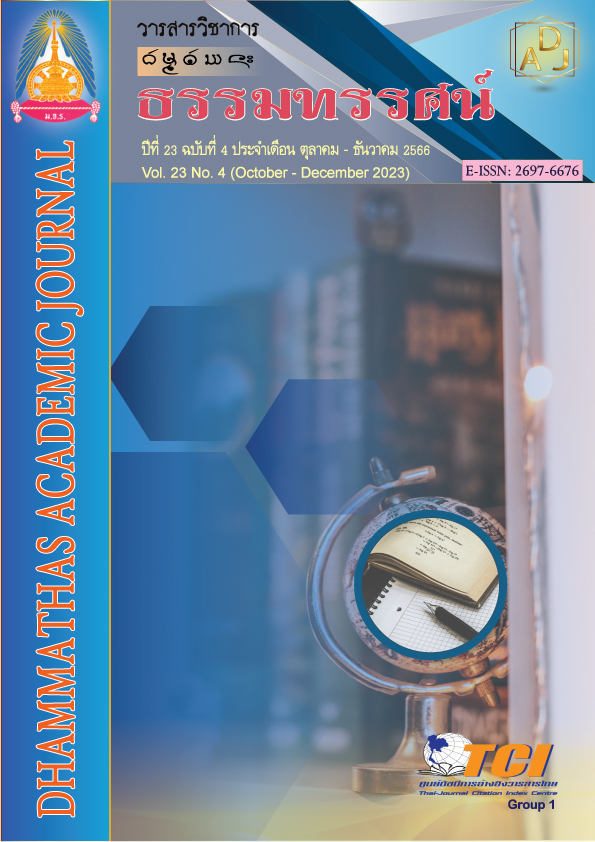Students’ Conceptual Understanding on Division with Decimals in Mathematics Classroom
Main Article Content
Abstract
This research aims to analysis and understand the conceptual knowledge of students about dividing decimals in mathematics classes that uses lesson study classroom through the method of Open Approach. The target group of this research is 15 primary school students in the academic year 1/2020 at Ban Bueng Niam Bueng Krinoon Tha Hin School. This class manages the study by using an open approach method, the research tools used for data collections were: 7 lesson plans in unit 6 about decimal divisions. The data analysis in this research were 1) protocol 2) students' activity sheet 3) field notes records. Data were analyzed according to the conceptual framework of Kilpatrick et al. (2001)
The study found that: The results showed that mathematics classrooms that uses lesson study in the method of Open Approach is a teaching method that focuses on problem solving processes. There are lesson plans that allow students to learn on their own. They could gain enlightened understanding knowledge effectively.
1.Understanding Concepts
Students demonstrate the principle of decimal division by changing the smallest unit to make decimal numbers into integers and Students show the evidence that the definition of decimal division is to make equal division.
2.Understanding Operations
Students show evidence of the mathematical symbols which include addition (+), subtraction (-), multiplication (×), division (÷) symbols that were used in solving problems. During the process, students can figure out which problem situations should be used with each mathematical symbol.
3. Understanding Relationships
Students show the principles of using different patterns that are related to each other to represent a variety of concepts. Students are able to convert decimal numbers to integers through the mathematical relationship of multiplication and division.. They also have discussions with their friends both in the group and in the whole class to present the relationship of decimal division.
Article Details

This work is licensed under a Creative Commons Attribution-NonCommercial-NoDerivatives 4.0 International License.
เพื่อให้เป็นไปตามกฎหมายลิขสิทธิ์ ผู้นิพนธ์ทุกท่านต้องลงลายมือชื่อในแบบฟอร์มใบมอบลิขสิทธิ์บทความ ให้แก่วารสารฯ พร้อมกับบทความต้นฉบับที่ได้แก้ไขครั้งสุดท้าย นอกจากนี้ ผู้นิพนธ์ทุกท่านต้องยืนยันว่าบทความ ต้นฉบับที่ส่งมาตีพิมพ์นั้น ได้ส่งมาตีพิมพ์เฉพาะในวารสาร วิชาการธรรม ทรรศน์ เพียงแห่งเดียวเท่านั้น หากมีการใช้ ภาพหรือตารางของผู้นิพนธ์อื่นที่ปรากฏในสิ่งตีพิมพ์อื่นมาแล้ว ผู้นิพนธ์ต้องขออนุญาตเจ้าของลิขสิทธิ์ก่อน พร้อมทั้ง แสดงหนังสือที่ได้รับการยินยอมต่อบรรณาธิการ ก่อนที่บทความจะได้รับการตีพิมพ์References
ไมตรี อินทร์ประสิทธิ์ และคณะ. (2546). การปฏิรูปกระบวนการเรียนรู้วิชาคณิตศาสตร์ในโรงเรียน โดยเน้นกระบวนการทางคณิตศาสตร์. ขอนแก่น: ขอนแก่นการพิมพ์.
ไมตรี อินทร์ประสิทธิ์. (2557). กระบวนการแก้ปัญหาในคณิตศาสตร์ระดับโรงเรียน. ขอนแก่น: เพ็ญพรินติ้ง.
สุกัญญา ธรรมนูญรักษ์, นฤมล ช่างศรี และไมตรี อินทร์ประสิทธิ์. (2558). ความเข้าใจอย่างรู้แจ้งเรื่อง การหารของนักเรียนในชั้นเรียนคณิตศาสตร์ที่ใช้การศึกษาชั้นเรียนและวิธีการแบบเปิด. วารสารศึกษาศาสตร์ มหาวิทยาลัยขอนแก่น, 38(3), 185-192.
Bell, A., Fischbein, E. and Greer, B. (1984). Choice of operation in verbal arithmetic problems: The effects of number size, problem structure and context’. Educational Studies in Mathematics, 15, 129-147.
Fischbein, E., et al. (1985). The role of implicit models in solving verbal problems in multiplication and division. Journal for Research in Mathematics Education, 16, 3-17.
Graeber, A., & Tirosh, D. (1990). Insights fourth and fifth graders bring to multiplication and division with decimals. Educational Studies in Mathematics, 21, 565-588.
Hiebert, J., & Carpenter, T. P. (1992). Learning and teaching with understanding. In: D. A. Grouns (Ed.), Handbook of research on mathematics teaching and learning (pp. 65-92). New York: Macmillan.
Hooper, S. B. (2015). Move the Decimal Point and Divide: An Exploration of Students’ Introduction to Division With Decimals. (Dissertation). Atlanta, GA: Georgia State University.
Inprasitha, M. (2011). One Feature of Adaptive Lesson Study in Thailand: Designing Learning Unite. Journal of Science and Mathematics Education in Southeast Asia, 34(1), 47-66.
Kilpatrick, J., Swafford, J. & Findell, B. (2001). Adding it up: Helping children learn mathematics. Washington, DC: National Academy Press.
Okazaki, M., & Koyama, M. (2005). Characteristics of 5th graders' logical development through learning division with decimals. Educational Studies in Mathematics, 60, 217-251.
The National Council of Teachers of Mathematics (NCTM). (2000). Principles and Standards for School Mathematics. Reston: NCTM.

